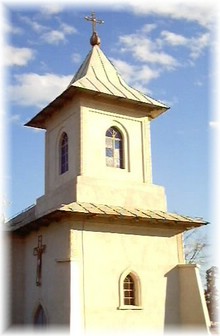
Biserica "Sf. Neculai"
Rezolutie recomandata
1024x768
|
 |
 |
- Documentary attesting
Hirlau played a very special role in the agitated history
of medieval
Moldova. The first documentary attestation about Hirlau
is bind to the Court of Lady Margareta Musat (the mother of the
leader Petru I Musat)
that was set here on the 1st of May 1384.
Its
importance grew during the leadership of Stefan cel Mare,
who rebuilt the court of the princely palace in 1486 and six
years
later, he added an architectural jewel: the Saint
George Church -
the first monument with a great scenery painted outside.
On the 12th of July 1499, Stefan cel Mare signed the Peace
Treaty with the king Ioan Albert of Poland in Hirlau, fact that proves
both the leader's victory on the battle
fields, and the town development.
Petru
Rares was proclaimed by Stefan cel mare as the
leader of Hirlau.
During Radu Mihnea's leadership Hirlau became princely
residence
and was the place where the leader died, in January 1626.
After this age of glory, Hirlau slowly begun to fall
into decay,
so that there are few documents to remind about it.
- Historical vestiges
In
the center of the town there are the ruins of the Musatini Princely
Court. It was the Stefan ce Mare's favourite residence and
later
Mihnea Voda moved there the capital of Moldova (the 2nd of October
1624).
Since 1985, the House of the chancellor Tautu's
descendants has been
sheltering the History and Etnographic
Museum.
Around Hirlau anybody can admire the geto-dacian fortress from
Catalina-Cotnari,
that has been lasting since IV-III centuries B.C.,
the ruins of Latin School from
Cotnari, those of the Castle from
Ceplenita belonging to the chronicler Grigore
Ureche and
the small convents from Deleni
.
- Religious tradition
Saint George Church, a gorgeous architectural monument that was
built by Stefan cel Mare in 1492,
is one of the most
interesting site in the country.
Saint Dumitru Church was built by Petru Rares in
1542 and represents an
harmonious joining of the Byzantine and Gothic
styles.
The Catholic Church was rebuilt in 1600.
- Culture
Since 1918, in Hirlau has been developed a real spiritual activity.
The cultural and
artistic activities were organized at the library.
On the 21st of October 1992
the Youth Society was founded.
On the 29th of June 1925 the library was changed into
the "Petru Rares" Cultural Home, in order to praize the
leader's
personality whose life and activity had been bind to
Hirlau.
- Education
In 1552, Alexandru Lapusneanu, founded the College from Hirlau,
the first lay school in Moldova.
The "Stefan cel Mare" Primary Boys School was built later,
in 1881,
followed by the Girls School, in 1888. The two schools
became later a
Mixed General School in order to respond to the
need of enlarging the
learning space.
The Mixed Gymnasium was set up in 1953 and later, it was changed
into the theoretical High School.
In Hirlau there is a sports association.
The town team of oina
(similar to baseball) gained the national champions title three times,
and once the national
vice-champions title.
- Touristic interest
Passing through Hirlau, the
tourists can admire the elegant
silhouette of the hotel symbolicaly
named Raresoaia.
Another touristic attractions are the oak reservations from Humosu
and Basaraba.
The tourist activity of Hirlau includes:
- 10 sightseeings;
- a hotel with 60 rooms;
- a pupil camp (Pircovaci);
- a summer camp at Poiana Deleni.
- Economy
The most important occupation of the
inhabitants is
agriculture: harvesting and animal breeding.
They also do gardening,
vinning and fruit growing.
Trade had begun to develop since XV-XVI centuries.
Until 1968 there were only small workshops.
If in 1968 there were only 68 flats, in 1980 their number had raised
at 1,018, and in 1997 at about 2,000 flats.
A hospital, an urban medical unit, a 400 places hostel-hospital,
a
polyclinic and two pharmacies carry on their activity in Hirlau.
There are three state banks and two private ones.
|






